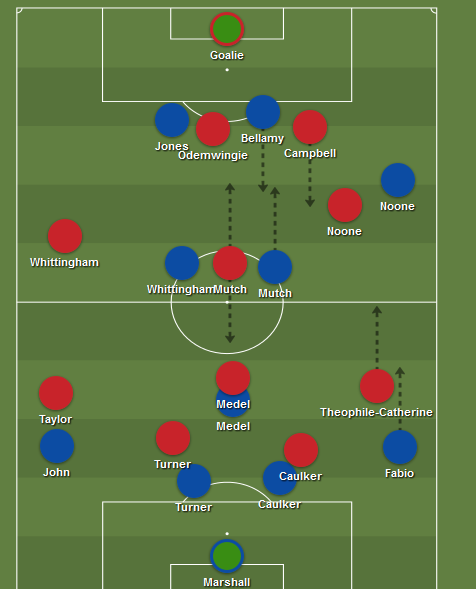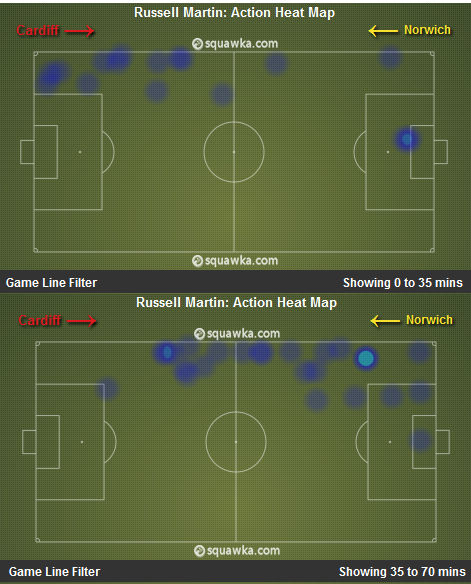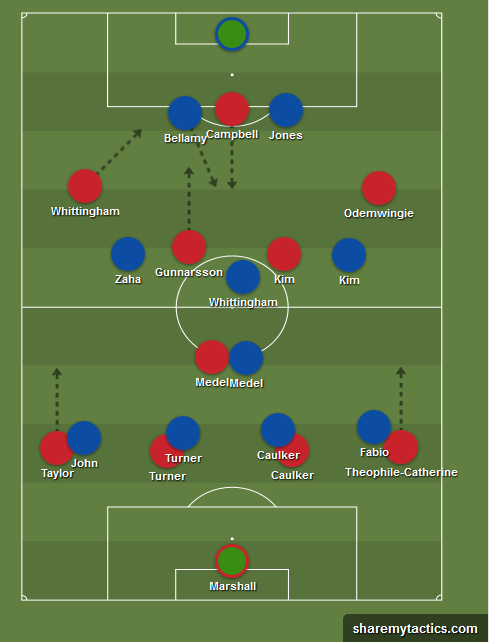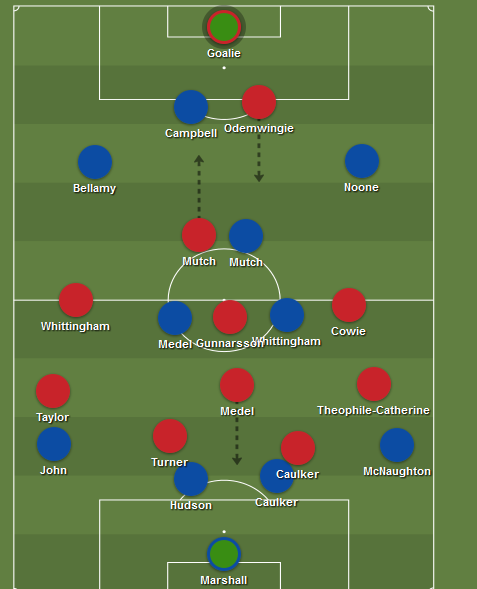Malky and Ole – a look at their styles
Over the Christmas period, Cardiff replaced Malky Mackay with Ole Gunnar Solskjaer as manager. If their respective approaches could be summed up, it would be that Solskjaer tries to win while Mackay tried not to lose.
At least, that’s the theory. Cardiffkickaball takes a look at how true this is.
How do you compare two different managers at one club?
Their players might be generally the same but the other variables that come into play (injuries, form, opposition, and so on) make direct comparisons tricky. We’ll divide the matches played so far into four categories; firstly, home and away and then into those teams who’ll be fighting it out for European qualification (where Cardiff were the underdog) and those who Cardiff stood a chance against (the rivals). There are usually better and worse times to face these rivals so the table below shows the form of the opposition coming into the match. The figure in brackets is the number of points won by the opposition in the preceding six games – why six games? Well, why not.
| Ole | Malky | |||
| Home | Away | Home | Away | |
| Rival | Norwich 2-1 (5) | Swansea 0-3 (4) | West Brom 1-0 (5) | Fulham 2-1 (4 from 5 games) |
| Villa 0-0 (7) | Swansea 1-0 (8) | Palace 0-2 (7) | ||
| West Ham 0-2 (2) | Newcastle 1-2 (7) | Villa 0-2 (8) | ||
| Southampton 0-3 (2) | West Ham 0-2 (-) | |||
| Norwich 0-0 (6) | ||||
| Stoke 0-0 (6) | ||||
| Hull 1-1 (3 from 3 games) | ||||
| Underdog | Man Utd 0-2 (12) | Man Utd 2-2 (13) | Chelsea 1-4 (11) | |
| Man City 2-4 (18) | Man City 3-2 (3 from 1 game) | Liverpool 1-3 (13) | ||
| Spurs 0-1 (9 from 4 games) | ||||
| Everton 0-0 (2 from 2 games) | ||||
| Arsenal 0-3 (13) |
The three colours indicate the pairings that we’ll take a look at, trying to find two opponents with similar form, starting with…
West Brom and Norwich
Cardiff’s most recent two league victories of the season were against West Brom and Norwich at home, with both opponents coming into the game with five points from the previous eighteen. Cardiff’s lineups in both games are below.
Against West Brom (red), Mackay played one of his most attacking formations, the match being one of the few occasions under him where two strikers were used. Noone had his first start of the season and impressed in the early stages of the match, fading (understandably) later. Although the strikers had changed by the time Norwich (blue) came around, the lineup was quite similar. Medel played the same position, defending the back four on his own, Noone again played on the right with Mutch central and Whittingham frequently coming inside and leaving the left flank open.
However, this lineup did not last long against Norwich. While Cardiff started brightly against West Brom, peppering their goal in the first half hour, it took only a few minutes for Norwich to take the lead. Solskjaer quickly realised his mistake and brought Zaha on for Whittingham, a rare tactical first half substitution. This gave Cardiff width and balance and also gave Norwich’s right back Russell Martin something to think about. His two heatmaps below show how he’d played most of the opening 35 minutes (top) in the Cardiff half but these opportunities disappeared from 35-70 minutes (bottom).
Cardiff scored the two goals that won the Norwich game in the space of one second half minute but they failed to kill the game off and Norwich fired in shots over the last half hour in a futile attempt to equalise. West Brom also did this to try and get an equaliser, Whittingham having scored a rare header to give Cardiff the lead, but not on the scale of the Norwich game. While WBA hit six attempts in the final 30 minutes, Norwich managed seventeen and could not believe that none of them went in.
As is often the case in single goal victories, there were moments in both games where the points could have been lost. Of these two matches, there is little doubt that win against Norwich was the more fortuitous. But Solskjaer’s willingness to fix something broken, even in the first half, was encouraging. Managers won’t always get things right to begin with and Solskjaer appears to be one of the few who don’t see an early switch as a mistake they are too proud to change.
Fulham and Swansea
Now – this match up is not going to be fair. Solskjaer has only taken Cardiff to the away ground of one of their bottom half rivals and it happened to be Cardiff’s worst performance of the season (at Swansea, of all places). Nonetheless, it has to be chosen. And of all the games to pair it with, it’s Cardiff’s only away win, at Fulham. Swansea came into the match with four points from their previous six games, the same number that Fulham had won (albeit from five matches as the season was young).
Solksjaer took a man out of midfield against one of the league’s most possession heavy sides, perhaps hoping that the Swansea (blue) midfield was depleted enough to take advantage. He was wrong and Swansea coasted to an embarrassingly easy three points. Cardiff used two strikers but could get neither into the match and the fullbacks, particularly Fabio, were caught out of position frequently.
At Fulham (red), Mackay played a conservative one man up front and yet struck 22 attempts on the Fulham goal (although accuracy was not impressive). The midfield, particularly Gunnarsson, did well to get forward, thanks to Medel putting in an excellent performance behind them. It should be noted that around half of Cardiff’s efforts came from set pieces, which is something that has dried up under Solskjaer.
The big difference between the two games was the amount of ball Cardiff won in midfield. Whittingham was overrun in the centre against Swansea and Cardiff frequently went back to the goalkeeper. Against Fulham, eight Cardiff outfielders had more touches of the ball than Marshall; against Swansea, only Medel and Whittingham did. Swansea pressed Cardiff into turning backwards far more often than Fulham (no team can press from the front when the forwards are Bent and Berbatov) but when Cardiff needed options in attack, like Kim, Zaha and Bellamy should have been providing, there was nothing available.
Chelsea and Man Utd
For the final pairing of games, Cardiff travelled to play Chelsea (red) under Mackay and Man Utd (blue) under Solskjaer. At Stamford Bridge, Cardiff again played with one man up front and a defensive looking midfield containing Mutch playing what is his best role, as a midfielder attacking from deep. His running was rewarded in this game, as he gave Cardiff a surprising early lead by closing down a backpass to Cech. At Old Trafford, there was also an early goal but this was scored by van Persie. Cardiff then had little choice but to come forward, and they did this quite well, with Medel and Whittingham playing alongside each other in the centre, rather than Medel sitting back.
Cardiff actually had more possession over the 90 minutes at Old Trafford, but Man Utd restricted them to staying in their own half – Medel took just 21% of his touches in the opposition half. While it might look good to win the possession battle in such a game, in reality this was a beleagured Man Utd team who were happy to let Cardiff have the ball in unthreatening positions and run out the clock (even from the 6th minute goal) to pick up their win. Cardiff managed just a single shot on target, and that was from outside the box.
Noone was Cardiff’s most dangerous player, only Young and debutant Mata had more touches in the opposition final third, but Cardiff’s front three were all too similar in style and small in stature. Cardiff put in 21 crosses, with only a third finding a man, and without Man Utd’s full backs needing to attack there was little opportunity for the wide men to cut inside and create something.
At Stamford Bridge, Cardiff’s game plan to keep Chelsea at bay took on renewed vigour with Mutch’s goal. They held out remarkably well and can only dream of what could have been had they gone in at half-time 1-0 up – instead, Eto’o sneakily, and in the view of many observers, wrongly, robbed Marshall of the ball to equalise. But whilst Chelsea had had plenty of the ball, they did not create many good chances. At least, not until the second half, when a combination of Cardiff’s tiredness, Medel’s substitution and Chelsea’s class resulted in the expected goals flying in. Even then, Cardiff still counterattacked well.
Conclusion
Football is a game of trying to score goals and stopping the other team from doing the same. Managers metaphorically live or die on how their team balances these priorities, and upon which they place more emphasis. If rumours are true, part of the reasoning behind Mackay’s departure was his preference for defending. Despite that, in all of these featured games, the Mackay team scored first while Solskjaer’s team has fallen behind first in every league match (except the 0-0 draw with Villa).
In these featured matchups, the difference between the two managers’ shot ratios (shots taken:shots allowed) is startling; Ole 27:61, Malky 46:41. This is very skewed thanks to the inclusion of Fulham/Swansea, but considering the season so far, it is clear that Cardiff are not better in attack under Solskjaer by the same proportion that they are weaker in defence. Despite this, both managers can thank one man for saving points in just about every match – David Marshall in goal. Without him, both approaches would have been doomed to failure. But Solskjaer comes in to the job with at least the chance to fulfil his remit to stay up with more attractive football.
Doing this with a squad bought to play defensively and a midfield who can counter attack but not hold possession in the opposition half is a task probably at the limit of his capability. Mackay, with a few seasons behind him at Cardiff, would have found it difficult enough to reshape a squad in January and Solskjaer had little chance. He has brought in players he knows from Norway and others with some calibre in England, Jones and Zaha, which is about all he could do on the budget.
But there is a genuine worry from his matches so far that the gap between Cardiff and their opponents looks wider under him than it did under Mackay. With matches running out to save their skin, Cardiff cannot allow this gap to widen.
Graphics provided by:
sharemytactics.com
squawka.com



